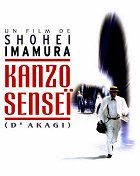Rendező:
Shôhei ImamuraOperatőr:
Shigeru KomatsubaraZeneszerző:
Yōsuke YamashitaSzereplők:
Akira Emoto, Kumiko Aso, Jacques Gamblin, 松坂慶子, Misa Shimizu, Tomorowo Taguchi, Masayuki Ibu, Ayumi Itō, Ben Hiura, Kazuhiko Kanayama, Yukiya Kitamura (több)Recenziók (2)
Imamura always approached his characters as representatives of the human race with genuine fascination, but whereas in the 1960s his films were characterised by a rather anthropological coldness and a satirical, and thus essentially evaluative, point of view, the films from the last third of his career radiate greater enthusiasm for and sometimes even celebration of the everyday and corporeal as the basis of all human actions. We can see this slight change not only as the maturation of his creative approach, which tellingly came after the director’s documentary period, when he got a better insight into the realistic archetypes for the heroes and heroines of his fictional films, but also as an expression of defiance against the increasing aloofness and artificiality of (not only Japanese) society in the last decades of the twentieth century. Imamura’s jovial odes to human nature, such as Zegen, Dr. Akagi and Warm Water Under a Red Bridge, are peculiarly and unfairly overshadowed by his seemingly more serious films such as The Ballad of Narayama and Black Rain. However, his films like Dr. Akagi are the essence of Imamura’s approach to the human race and its toil set against the backdrop of major historical events. The titular Dr. Akagi is the quintessential Imamura protagonist – a character of the people who has been forgotten by history, but whose story can tell us much more about the people and, in particular, the Second World War than any heroic epic can. The ridiculous, eager little man, obsessed with the idea of hepatitis infection and diagnosing all of his patients with hepatitis as a matter of principle, is simultaneously a fool, a hero and a subversive saviour when he administers glucose and prescribes bed rest and a hearty diet to everyone around him at the end of the war, a time of tense uneasiness, dwindling food rations and feverish, unrealistic efforts to reverse the course of the war. At the same time, his story is also about the bitter conflict between a man with the ambition to help and the machinery of history represented by a tenaciously stupid and limited military apparatus (in this respect, one of the highlights of the film is the moment when the doctor uncovers the cause of the hepatitis epidemic). Imamura populates the film with a fascinating gallery of supporting characters, all of whom not only aid the depiction of the absurdity of the war situation, but also express the amazing togetherness of people at a time when the absurd civilisational concepts of hierarchy, morality, ethics and good reputation have simply ceased to apply. Besides the profligate Buddhist monk and the brilliant morphine-addicted surgeon, a stand-out character is the girl Sonoko, whom the doctor hires as a nurse so that she will stop selling herself, but she fails to follow through with this because of her ridiculous circumstances and is even discouraged from doing so by her younger siblings. Together with Zegen, Dr. Akagi is a wonderfully absurd depiction of the Second World War in the Japanese context that will leave viewers with a bittersweet feeling of catharsis over the essence, futility and, mainly, foolishness of human drudgery. Paradoxically, it can even be said that in these films Imamura actually achieved that classic aesthetic ideal of mono no aware (the pathos of fleetingness in relation to human actions), so greatly promoted by Yasujiro Ozu, with whom Imamura began his career as an assistant director, though even before making his own directorial debut, he had developed an aversion to the revered master and his value system (after leaving the Shochiku Studio, Imamura found an ideal mentor in Yuzo Kawaima, a hedonistic admirer of human baseness). Whereas Ozu melancholically lulls viewers with odes to the middle class, Imamura opens up for them a world free of bourgeois refinement and instead empathetically celebrates corporeality and instinct.
()
(kevesebbet)
(több)
The most important post-war Japanese director was undoubtedly Akira Kurosawa, but if I had to name the second in order among Japanese film masters, I would probably choose Shohei Imamura after a brief hesitation, one of the key creators of the Japanese New Wave, who once intrigued me with his film Ballad of Narayama. The New Wave has long been passé, but Imamura returned to its style and goals in the late 90s when he directed the film Dr. Akagi. In this title, all the main traits of his work are evident: an interest in the periphery - the main character is a rural doctor from a remote province, a focus on the underworld of human society - the main character is a scholar who is led by exemplary noble motives, but he is surrounded by a strange group of drug-addicted colleagues without ideals and goals, a gluttonous alcoholic priest, and a prostitute whom Dr. Akagi has decided to reform. Imamura often operated in the genre of satire, and even here, his film functions much more as tragicomedy or dark comedy than as a drama. The story takes place in the last months of World War II between the suicide of the Imperial Chancellor and the dropping of the atomic bomb on the Japanese archipelago. Imamura mockingly portrays the agony of the military regime, and its incompetence, selfishness, and corruption. He does not spare his protagonist either, although he views his actions with kindly understanding when he ironically criticizes his patriotism and belief in traditional institutions and values. Imamura's view of Japan in the last weeks before surrender is original, spiteful, and entertaining. Overall impression: 80%.
()

